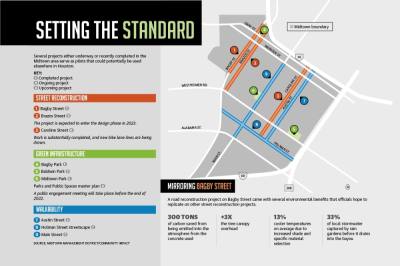Houston is exploring ways to become a more sustainable city when it comes to urban design, and planners in Midtown said they intend to lead the way when it comes to how they design streets, parks and other gathering spaces.
Efforts focused on reducing car reliance, using sustainable construction materials and prioritizing green infrastructure—once considered offbeat and of lesser priority—are starting to become the new standard, with both financial and environmental benefits, said Marlon Marshall, director of engineering and construction with the community group Midtown Houston.
“The environmental benefits are the ones we knew would help out the community,” he said. “We meet with ... other organizations that are looking to do similar things, and they come down and visit and want to understand the basis of the development.”
At the same time, the city of Houston entered a new chapter in its push toward sustainability in 2021 with the launch of several new incentive programs for sustainable development, including property tax abatements, award programs and a new pilot program to speed up the permitting process.
Project updates
Several projects underway by the Midtown Redevelopment Authority follow in the footsteps of a Bagby Street reconstruction project completed in 2013, Marshall said.
That project, which spanned from just south of I-45 to Tuam Street, was Texas’ first road to be Greenroads certified, a designation given out by the Greenroads Foundation for how designers take the environment, access, construction practices and materials into account. Greenroads officials highlighted rain gardens that treat and capture 33% of the stormwater that falls within the right of way, LED street lighting, cool pavement materials, and the use of native vegetation.
These same elements are being incorporated a $14.5 million reconstruction of Caroline Street, Marshall said. The project, which was completed in September aside from a few final punch list items, features rain gardens that help filter stormwater before it heads into Buffalo Bayou as well as new concrete designed to reduce carbon emissions.
The Bagby standards will also be incorporated when Brazos Street is reconstructed as well, Marshall said. Design work on the project will start in 2023, he said.
Since 2013, the concrete used on Bagby has saved 300 tons of carbon from being emitted into the atmosphere, Marshall said, citing the Greenroads Foundation.
Work being done at the hyperlocal level by groups like the Midtown Redevelopment Authority is crucial in the larger battle against climate change, said Lara Cottingham, chief of staff with the Houston branch of Greentown Labs, a prototyping lab and office space that launched in 2021 in Midtown to foster collaboration on climate change technology projects.
“Communities and neighborhoods can be a test bed,” she said. “They can be a place where you have a little more local control. Midtown has long been a leader in smart and sustainable development.”
In addition to Midtown’s streets, green infrastructure is also incorporated into park projects. Midtown Park opened in 2018 at the heart of the district with a wetland stream that mimics the effect of a bayou—treating stormwater before it runs into Houston’s sewer system.
“Not only are they helping to address drainage issues, but they also clear the pollutants in the water,” Marshall said.
The redevelopment authority is in the middle of the public engagement process for a new parks master plan, which Marshall said will help guide similar projects moving forward. A public input meeting will take place before the end of the year, he said.
The bigger picture
The work in Midtown is moving forward at a time Houston Mayor Sylvester Turner has been promoting sustainability through several plans: the Resilient Houston plan and the Houston Climate Action Plan, both adopted in 2020. Turner has set a goal of making Houston carbon neutral by 2050.
In August 2021, the city adopted its Incentives for Green Development guidelines, which seek to provide ways the city can encourage private developers to take sustainability into account when drafting their plans, including through property tax abatements. New development guidelines focus on stormwater infrastructure, which strives to mimic how rain falls on undeveloped green landscapes.
Houston has implemented 40 green stormwater projects since August 2021 with a goal of implementing 100 by 2025. Projects are scattered across the city, including several private developers across Downtown and Midtown that have added green roofs, which involve planting vegetation over a waterproofing system, according to Houston records.
Green roofs can improve water treatment, heat mitigation and carbon capture, according to the authors of Houston’s Incentives for Green Development plan.
“Integration of green stormwater infrastructure into the planning and development of public and private assets needs to become ‘business as usual’ for all property developers in Houston,” authors wrote in the plan.
Houston also plans to launch pilot program with the goal of expediting permits for developers that are working on resilience projects, a move Turner described as “future-proofing the city.” At least 10 developers will be included in the pilot, and the city will work with them to test and formalize the process of speeding up applications, Turner said in a news release.
Marshall said the city has advanced a lot since the redevelopment authority embarked on the Bagby project more than a decade ago.
“Back when we designed Bagby, we had to convince folks that this was the right thing to do,” he said. “Now [these projects] are becoming the standard.”






